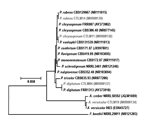Heavy metals tolerant microorganisms from mine tailing wastelands Santa Rosa, Jangas (Peru)
DOI:
https://doi.org/10.15381/rpb.v26i1.15914Keywords:
Polluted soils; Fusarium; Penicillium; Bacillus; Serratia.Abstract
In this work, we studied the degree of tolerance to heavy metals of fungi and bacteria isolated from soils with and without rhizosphere, in order to know its potential for applications in bioremediation. The samples came from Santa Rosa de Jangas mining liability. The fungi and bacterial strains were taxonomically identified by ITS region and 16S rDNA analysis, respectively. Heavy metal tolerance indices were calculate using salt medium supplemented with 1mM of lead (II), cupper (II), nickel (II) or zinc (II); and 0.1 mM of silver (I), chromium(VI) or cadmium (II). It was isolated 23 fungi and 18 bacteria strains. The fungi with better tolerance indices were Fusarium temperatum CTLM05 (Pb+2), Fusarium temperatum CTLM08 (Zn+2), Fusarium oxysporum CTLM18 (Ni+2 and Cd+2), Fusarium oxysporum CTLM12 (Ag+1), Fusarium inflexum CTLM22 (Cu+2), and Penicillium vanluykii CTLM11 (Cr+6). Likewise, the bacterial strains with better tolerance indices were Bacillus licheniformis SSR18 (Cd+2, Ni+2 and Zn+2), Bacillus subtilis SSR3 (Pb+2), Serratia sp. SSR15 (Cu+2), Serratia sp. SSR13 (Ag+1) and Bacillus cereus SSR01 (Cr+6). Too, it was found that fungi showed better tolerance indices than bacterial strains. Finally, the soil from Santa Rosa waste mine have an interesting microflora, probably with mechanisms for their adaptation, growth, and development were heavy metals are present and they could be useful to perform biotechnology and bioremediation processes.
Downloads

Downloads
Published
Issue
Section
License
Copyright (c) 2019 Loyer Muñoz-Silva, Percy Olivera-Gonzales, Miguelina Santillán-Torres, Carmen Tamariz-Angeles

This work is licensed under a Creative Commons Attribution-NonCommercial-ShareAlike 4.0 International License.
AUTHORS RETAIN THEIR RIGHTS:
a. Authors retain their trade mark rights and patent, and also on any process or procedure described in the article.
b. Authors retain their right to share, copy, distribute, perform and publicly communicate their article (eg, to place their article in an institutional repository or publish it in a book), with an acknowledgment of its initial publication in the Revista Peruana de Biologia.
c. Authors retain theirs right to make a subsequent publication of their work, to use the article or any part thereof (eg a compilation of his papers, lecture notes, thesis, or a book), always indicating its initial publication in the Revista Peruana de Biologia (the originator of the work, journal, volume, number and date).





